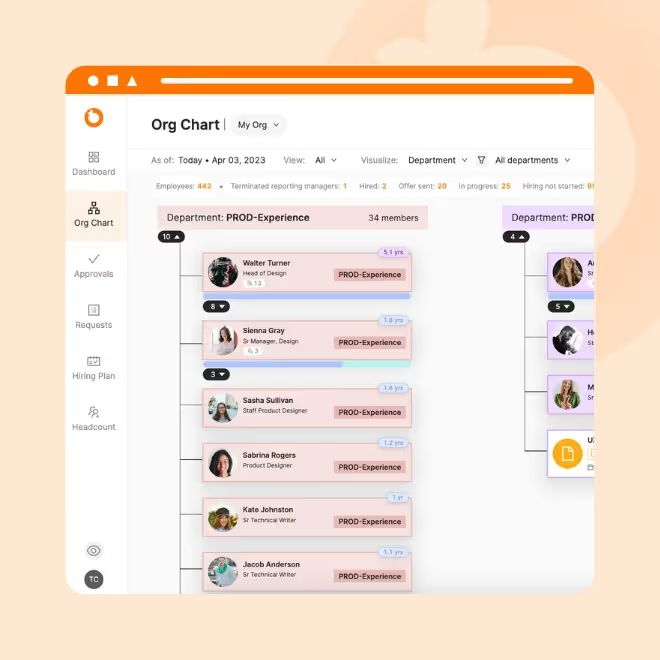Why you need good org chart software for effective headcount management

In this article
Never miss new content
Headcount planning is a complex and dynamic process — which has historically made it a huge headache. You need to balance company goals with budget constraints and hire at just the right pace while bringing together hiring managers and team members from Finance, HR, and Talent Ops. And you need to be able to pivot quickly when things change, because they will, more than once.
Headcount planning is complicated, but it doesn’t have to become a headache. With a solid process and the right tools, we’ve seen companies turn headcount planning into a process the whole team is excited about instead of one they dread.
When headcount planning is streamlined and collaboration is easy, everyone is empowered to make better strategic decisions that support business growth and scalability. This guide breaks down the headcount planning process with tips from Talent, People Ops, Human Resources, and Finance leaders at companies that have scaled successfully. We also turned the process outlined in this article into a free headcount planning checklist you can use again and again during your planning cycles.
What is headcount planning?
Headcount planning is the strategic process of mapping out how your business is going to increase your workforce to support your business goals. A good headcount plan serves as your business roadmap to hiring the right people with the right skills in the right roles at the right time, all while staying within budget.
Since employees often represent the largest portion of a company's operating budget, typically 70% of OPEX, effective headcount planning is essential for maintaining efficiency and productivity. Businesses must carefully assess how workforce changes impact financial performance and operational success.
What is the difference between headcount planning and workforce planning?
Many organizations use the terms headcount planning and workforce planning interchangeably, but they aren’t exactly the same. Headcount planning is part of workforce planning, but workforce planning covers a broader scope.
A headcount plan is a detailed map of how a company is going to grow their team. It outlines how many new positions you intend to fill in a given time period, what the estimated compensation package and start dates would be for those positions, and who each new hire would report to.
A workforce plan, on the other hand, maps out how a company’s existing organizational structure will need to change in order for the company to reach its goals. A workforce plan includes a headcount growth plan for new hires but also accounts for organizational restructuring, acquisitions, internal employee transfers from one department to another, succession planning, and attrition. Workforce planning is more common at large organizations with ~1,000+ employees.
Why it’s important to get headcount planning right
Headcount is the largest expense for most companies at ~70% of total OPEX. And effectively planning for that expense can literally be the difference between a company thriving or going under.
Get your headcount planning right, and you set your company up to reach your revenue and growth goals.
Get the headcount plan wrong, and your business will either be under or over-resourced. Either imbalance diminishes your ability to scale, adapt, and ultimately survive. Under-hire and you could miss your revenue and growth targets or fail to raise your next funding round. Over-hire and you risk burning through your cash runway too fast and ultimately looking at layoffs.
As Somrat Niyogi, Partner at Recall Capital and former General Manager & Head of Business Development at Gusto, told us on our podcast, “...in order to achieve any business outcome, you need to have the right people in the right roles with the right functional design, with the right levels, and the right management structure. And so to me, planning, particularly around what type of organization are you actually trying to build, can really dictate the success of your business.”
The headcount planning process in 8 steps
We recommend using a hybrid approach that combines top-down and bottom-up budgeting and goal setting when creating a headcount plan.
1. Understand your top-down business needs
Your headcount plan needs to align with your company’s high-level business objectives and annual budget. Before Finance, HR, and Talent teams can start planning, executives need to provide the high-level business goals that the headcount plan will roll up to.
Make sure your headcount planning team can answer the following questions:
- What are our investors' expectations?
- What are our business and revenue goals for the next 12 months?
- What are our business and revenue goals for the next 24 months?
- What is our current number of employees?
- What is the structure of our existing org chart and should that change?
- What new roles do we require to meet our business objectives?
Jim Miller, VP of People & Talent at Ashby, explained on our podcast, “You have to know what the outcome you're trying to reach and when is, and then you reverse that and you plan all the way back with milestones set all the way.”
Miller added, “The C-suite should not be the audience of your headcount plan… It's integral that they are the owners of their business and therefore, the owners of their portion of that plan. It doesn't get delivered to them. They're part of the building of it.”
2. Understand your bottom-up business needs
Next, determine what various departments require in order to support the broader business goals. Talk to different department heads and managers to ensure you can answer the following questions:
- What are our current workforce skill gaps?
- What kind of talent and types of roles do we need to address each department’s needs?
- Would it make sense to move any employees between departments to fill gaps?
- Is anyone currently overburdened?
- If a team member is overburdened, is there software or automation that could solve the problem or delay the need for an additional hire?
3. Agree on a single source of truth for data
Once you fully understand your strategic goals and resourcing needs, it’s time to dive into the numbers. You’ll need to agree on a single source of truth with accurate data that all teams will operate out of.
“Having a source of truth that is not a spreadsheet is really helpful. Because when we think about headcount planning, it is generally something that is driven by both finance and recruiting or the people team, but you also need to create transparency for your hiring managers or for your executive leaders.” Amanda Gregg, VP of People Operations at Parallel Bio and former VP of People at Second Front Systems, shared on our webinar.“
You need to be able to have different lenses for your different audiences and pointing everybody to a spreadsheet where somebody might accidentally delete something or make a comment somewhere that then creates a spiral is just not scalable and efficient… Having a tool and a source of truth that can be used at multiple levels cross-functionally across the organization is massively helpful.”
TeamOhana unites data from your FP&A, HRIS, ATS, and payroll systems into one collaborative platform, so everyone has access to real-time, accurate data. If you are still using spreadsheets, you’ll need to manually pull data from all of these other sources before you can begin to formulate a plan.
“We’ve implemented best-of-breed software:
Workday, Greenhouse, Adaptive Planning.
But we have headcount data in a lot of different systems. Nothing in the market could triangulate between budget forecasts, communication workflows, and having the right licensing model. Some of the bigger financial tools are great, but the UX and pricing models aren’t designed for collaboration. Meanwhile, spreadsheets fall short when you’re trying to run a highly transparent process, creating a lot of mental and administrative overhead to try and merge all of the information together to keep a single source of truth.”
4. Identify your key hiring metrics
It’s impossible to measure the success of your hiring plan and track your progress throughout the hiring process if you don’t know which metrics are most important for your business. It’s best to have a dashboard with real-time tracking, so you can monitor these metrics in real-time. We recommend including these metrics:
Simplifying TeamOhana: your questions, answered.
Yes, you can assign multiple recruiters to a role.
Yes you can make changes after a headcount has been approved. This is simply known as a change request and it triggers a separate approval workflow before it is merged into the plan.
It depends on the stakeholder, but the general answer is yes. TeamOhana scenarios are collaborative, so once you are satisfied with the plan you’ve created, you can invite others to view, leave comments, and (in some cases) edit it. Once you are all happy with the final output, you can request approval.
Yes, we can use performance data from any of the tools you use to make running a compensation cycle easy.

.svg)


